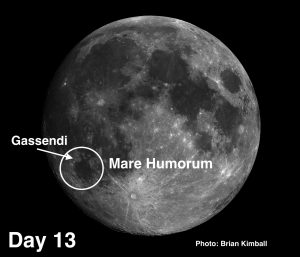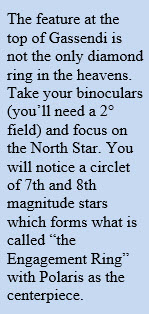 The week of December 17-23 takes us from the end of Day 9 through Day 16. This week we will highlight Mare Humorum, the Hippalus rilles, the craters Gassendi, Gassendi A (all viewable on Tuesday evening), and Comet 46/P Wirtanen.
The week of December 17-23 takes us from the end of Day 9 through Day 16. This week we will highlight Mare Humorum, the Hippalus rilles, the craters Gassendi, Gassendi A (all viewable on Tuesday evening), and Comet 46/P Wirtanen.
Mare Humorum: [SW/M6] The Mare Humorum (“Sea of Moisture”) basin is one of the best examples of subsidence that you can see on the Moon. As the basin sank under the weight of its lavas, arcuate cracks, which can be easily observed in small telescopes, opened up on the east side around Hippalus and on the west side. The craters Doppelmayer, Lee, Hippalus, and Loewy tilted inward and their seaward rims sank beneath the lava flows which covered Mare Humorum.
 Look closely at the Hippalus rilles just east of the mare. Notice how some of them plough through both mountain ridges and craters, and some are interrupted completely by small craters but continue on the other side. This gives you a clear indication of the sequence of activity. What features were in place before Humorum filled with lava and subsided? What features appeared after subsidence took place?
Look closely at the Hippalus rilles just east of the mare. Notice how some of them plough through both mountain ridges and craters, and some are interrupted completely by small craters but continue on the other side. This gives you a clear indication of the sequence of activity. What features were in place before Humorum filled with lava and subsided? What features appeared after subsidence took place?
Three generations of crater age can be easily observed on Mare Humorum. In descending order of age we have Mare Humorum itself1, which is overlapped by the younger crater Gassendi on the north rim, which in turn is overlapped on its north rim by Gassendi A. (Both Gassendis taken together are sometimes referred to as the diamond ring.) The usually dependable rule in play here is that smaller craters are younger (there are some exceptions). The invariably dependable rule is that the topmost overlapping crater is always younger.
 Gassendi is a double prize in that it is a floor-fractured crater with a nice set of central mountain peaks, the highest of which rises to 4,000 feet. It is also a textbook example of subsidence.2 Notice how there is a small amount of smooth mare inundation near the S.E. portion of the rim.
Gassendi is a double prize in that it is a floor-fractured crater with a nice set of central mountain peaks, the highest of which rises to 4,000 feet. It is also a textbook example of subsidence.2 Notice how there is a small amount of smooth mare inundation near the S.E. portion of the rim.
 Gassendi is considered to be one of the Moon’s most beautiful and interesting objects. To add to the interest, its floor is crisscrossed by a plethora of rilles (some authorities say there are at least 30). Several rilles in the southeast section can be easily seen with a 4-inch scope. The ones on the eastern half require larger apertures. Draw a map of what you can see, then come back later and try to improve on the count. (See how close you can get to 30.) Because its interior features change noticeably as the Sun rises higher, it is a rare event that any two observers will agree on the number and placement of the rilles. (You will probably discover that you will not agree even with yourself after visiting a few times.)
Gassendi is considered to be one of the Moon’s most beautiful and interesting objects. To add to the interest, its floor is crisscrossed by a plethora of rilles (some authorities say there are at least 30). Several rilles in the southeast section can be easily seen with a 4-inch scope. The ones on the eastern half require larger apertures. Draw a map of what you can see, then come back later and try to improve on the count. (See how close you can get to 30.) Because its interior features change noticeably as the Sun rises higher, it is a rare event that any two observers will agree on the number and placement of the rilles. (You will probably discover that you will not agree even with yourself after visiting a few times.)
While you’re in the area of Gassendi, be on the lookout for LTP’s. Several have been reported here.
Gassendi A: [SW/L6] This is the gemstone in the “diamond ring” mentioned above (the small unnamed crater at the top of Gassendi). Although Gassendi A is much smaller than Gassendi, its walls are one mile higher because it is not a floor-fractured crater; i.e., underlying pressure never caused its floor to rise abnormally, as is the case with Gassendi.
OF ADDITIONAL INTEREST IN SPACE THE WEEK OF DECEMBER 17-21:
On Friday morning Venus will occult a 6th magnitude star in Libra. In Colorado, where I live, the beginning of the occultation will be at 4:53 AM Mountain Time, but the star disappears behind the bright crescent of Venus which is so bright that it will wash out the star. However, the reappearance from behind the dark portion of Venus at 5:06 AM will be viewable. Portions of the United States farther west will not be able to view this event.
Great comet news! (Repeated from last week’s Blog.) The brightest comet this year is now in the skies, and it obligingly appears during the hours before midnight. On Monday Comet 46/P Wirtanen (“WERE-tuh-nun”) will be between the constellations Taurus and Perseus. Its closest approach to the Earth was Sunday night, Dec. 16. It is also the 20th closest comet in over 1,000 years and this week it is between 3rd & 4th magnitude. However, because the comet is very large (the coma is at least 1° wide, twice the size of the full Moon), and the light from it is very diffuse, it will be difficult to see. You will need an instrument with larger light gathering power than ordinary binoculars unless you’re under very dark skies. Unfortunately, full moon will be on Dec. 22. But on Christmas you’ll have an hour or so to view the comet in Auriga before the Moon rises, and a moonless viewing window will keep increasing after that.
On December 22nd, Comet Wirtanen will pass 2½° to the south of Capella, and a week later it will be visible most of the night without any lunar interference. About a half hour after the start of the New Year, it will stand more than 70° above the northern horizon, and probably hover at around 4th magnitude.
1 A mare (sea) is nothing more than a large crater that has been filled in with lava.
2 Due to dramatic subsidence, the walls of Gassendi slope down from a height of 6,100 ft. to a mere 200 ft. There seems to be one small breach where it looks like the wall has fallen almost to sea level.
======================
It is highly recommended that you get a copy of Sky and Telescope’s Field Map of the Moon, the very finest Moon map available for use at the telescope. It is available for $10.95 at www.skyandtelescope.com and on Amazon. All features mentioned in this blog will be keyed to the grid on the Field Map and will look like this: Plato: [NW/D9]
Credits:
Courtesy of Gray Photography of Corpus Christi, Texas
Lunar photos: NASA / USGS / BMDO / LROC / ASU / DLR / LOLA / Moon Globe. Used by permission
- Rupes Cauchy: A Best Known Fault on the Moon - July 22, 2024
- Moon Crater Schickard – Crater Floor has Stripes - July 15, 2024
- Moon Craters Langrenus and Vandelinus - July 8, 2024